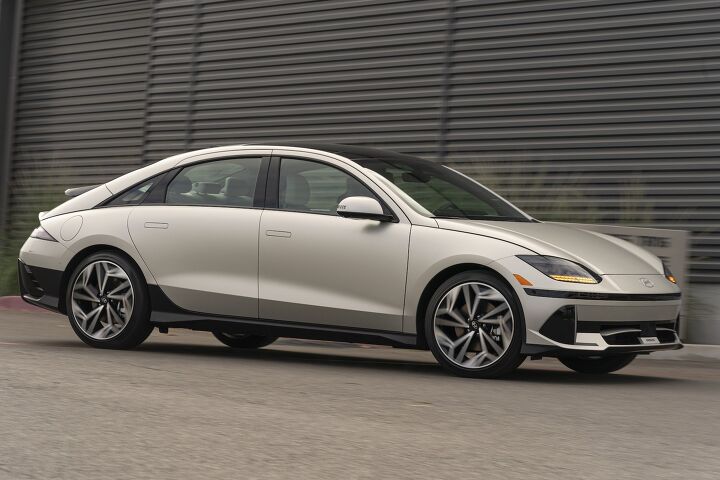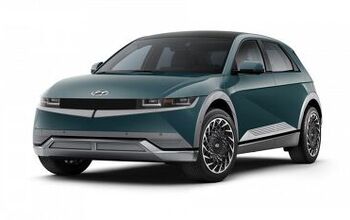The Right Spec: 2023 Hyundai IONIQ 6

The design studios at Hyundai are firing on all cylinders these days, ironic since some of the eye-popping vehicles they’re churning out don’t have any cylinders at all. The upcoming IONIQ 6 is one of ‘em, set to be offered in a number of trims and powertrain options.
Your author will ignore federal EV rebates in this post, partly because they can vary wildly depending on the circumstance but also because they cause his head to spin even worse than after his morning grog ration of Angel’s Envy whiskey. Sticking to MSRP, the least expensive trim is the SE Standard Range rear-wheel drive, equipped with a single 149 horsepower electric motor and a 53-kWh battery good for about 240 miles of driving on a full charge. This’ll ding yer bank account for $41,600.
Keeping in character for Hyundai, this model is bursting at the seams with content – even at its entry-level. Likely thanks to the economies of scale, the base trim still gets the dandy 800V architecture which can hoover up to 350kW of electricity from an appropriately robust Level 3 fast charger. This has the practical benefit of spending less time at public chargers during occasions when owners decide to dip off the highway for a jolt of electrons (and coffee while they wait).
Smart cruise control with stop-and-go capabilities, automatic headlight control, and enough LEDs to illuminate most of Las Vegas are all on this trim, along with heated side mirrors and flush door handles. These features have the ability to make the SE SR RWD look very much like its more expensive brethren. Colors can be a hot topic with EVs; get traditional white if you must but we feel expressive paint options are always a good bet.
Inside, look for comforts like power seats for the driver, heated chairs for both up-front occupants, and rear air vents for backseat ankle biters. Upholstery is cloth at this price, though the steering wheel does adjust for reach and rake whilst displaying a quartet of interactive pixel lights instead of a Hyundai logo. Fun fact: four dots indicate the letter H in Morse code. Dual automatic temperature controls keep warring factions at bay and there should be enough USB ports for everyone in the car – four USB-C and a USB-A.
Screen displays are top-tier, as they are in more expensive trims. Two 12.3-inch screens are part of the dashboard, one serving up critical vehicle information while the other handles navigation and infotainment. There are six speakers for the latter, plus wired smartphone integration and the expected Bluetooth gear. Over-the-air updates can be pushed to the car for whatever upgrades the mother ship feels are necessary. We can have that discussion another day.
Take the base trim, then? Not so much. It’s only a $3,900 walk to the next level trim (confusingly also called SE but dropping the ‘Standard Range’ suffix) but it brings more power and more range. Total output climbs to 225 horses, a 50 percent jump, and range vaults to an estimated 361 miles thanks to a 77.4-kWh battery pack. Note this is still a rear-wheel drive car (all-wheel drive costs a further $3,500).
Another big bonus with this trim is the inclusion of a heat pump, a type of technology that uses less electricity to warm the cabin than a relatively old-school resistive heater. For a sum of $45,500, this trim is our pick.
[Image: Hyundai]
Become a TTAC insider. Get the latest news, features, TTAC takes, and everything else that gets to the truth about cars first by subscribing to our newsletter.

Matthew buys, sells, fixes, & races cars. As a human index of auto & auction knowledge, he is fond of making money and offering loud opinions.
More by Matthew Guy
Latest Car Reviews
Read moreLatest Product Reviews
Read moreRecent Comments
- Kmars2009 I rented one last fall while visiting Ohio. Not a bad car...but not a great car either. I think it needs a new version. But CUVs are King... unfortunately!
- Ajla Remember when Cadillac introduced an entirely new V8 and proceeded to install it in only 800 cars before cancelling everything?
- Bouzouki Cadillac (aka GM!!) made so many mistakes over the past 40 years, right up to today, one could make a MBA course of it. Others have alluded to them, there is not enough room for me to recite them in a flowing, cohesive manner.Cadillac today is literally a tarted-up Chevrolet. They are nice cars, and the "aura" of the Cadillac name still works on several (mostly female) consumers who are not car enthusiasts.The CT4 and CT5 offer superlative ride and handling, and even performance--but, it is wrapped in sheet metal that (at least I think) looks awful, with (still) sub-par interiors. They are niche cars. They are the last gasp of the Alpha platform--which I have been told by people close to it, was meant to be a Pontiac "BMW 3-series". The bankruptcy killed Pontiac, but the Alpha had been mostly engineered, so it was "Cadillac-ized" with the new "edgy" CTS styling.Most Cadillacs sold are crossovers. The most profitable "Cadillac" is the Escalade (note that GM never jack up the name on THAT!).The question posed here is rather irrelevant. NO ONE has "a blank check", because GM (any company or corporation) does not have bottomless resources.Better styling, and superlative "performance" (by that, I mean being among the best in noise, harshness, handling, performance, reliablity, quality) would cost a lot of money.Post-bankruptcy GM actually tried. No one here mentioned GM's effort to do just that: the "Omega" platform, aka CT6.The (horribly misnamed) CT6 was actually a credible Mercedes/Lexus competitor. I'm sure it cost GM a fortune to develop (the platform was unique, not shared with any other car. The top-of-the-line ORIGINAL Blackwing V8 was also unique, expensive, and ultimately...very few were sold. All of this is a LOT of money).I used to know the sales numbers, and my sense was the CT6 sold about HALF the units GM projected. More importantly, it sold about half to two thirds the volume of the S-Class (which cost a lot more in 201x)Many of your fixed cost are predicated on volume. One way to improve your business case (if the right people want to get the Green Light) is to inflate your projected volumes. This lowers the unit cost for seats, mufflers, control arms, etc, and makes the vehicle more profitable--on paper.Suppliers tool up to make the number of parts the carmaker projects. However, if the volume is less than expected, the automaker has to make up the difference.So, unfortunately, not only was the CT6 an expensive car to build, but Cadillac's weak "brand equity" limited how much GM could charge (and these were still pricey cars in 2016-18, a "base" car was ).Other than the name, the "Omega" could have marked the starting point for Cadillac to once again be the standard of the world. Other than the awful name (Fleetwood, Elegante, Paramount, even ParAMOUR would be better), and offering the basest car with a FOUR cylinder turbo on the base car (incredibly moronic!), it was very good car and a CREDIBLE Mercedes S-Class/Lexus LS400 alternative. While I cannot know if the novel aluminum body was worth the cost (very expensive and complex to build), the bragging rights were legit--a LARGE car that was lighter, but had good body rigidity. No surprise, the interior was not the best, but the gap with the big boys was as close as GM has done in the luxury sphere.Mary Barra decided that profits today and tomorrow were more important than gambling on profits in 2025 and later. Having sunk a TON of money, and even done a mid-cycle enhancement, complete with the new Blackwing engine (which copied BMW with the twin turbos nestled in the "V"!), in fall 2018 GM announced it was discontinuing the car, and closing the assembly plant it was built in. (And so you know, building different platforms on the same line is very challenging and considerably less efficient in terms of capital and labor costs than the same platform, or better yet, the same model).So now, GM is anticipating that, as the car market "goes electric" (if you can call it that--more like the Federal Government and EU and even China PUSHING electric cars), they can make electric Cadillacs that are "prestige". The Cadillac Celestique is the opening salvo--$340,000. We will see how it works out.
- Lynn Joiner Lynn JoinerJust put 2,000 miles on a Chevy Malibu rental from Budget, touring around AZ, UT, CO for a month. Ran fine, no problems at all, little 1.7L 4-cylinder just sipped fuel, and the trunk held our large suitcases easily. Yeah, I hated looking up at all the huge FWD trucks blowing by, but the Malibu easily kept up on the 80 mph Interstate in Utah. I expect a new one would be about a third the cost of the big guys. It won't tow your horse trailer, but it'll get you to the store. Why kill it?
- Lynn Joiner Just put 2,000 miles on a Chevy Malibu rental from Budget, touring around AZ, UT, CO for a month. Ran fine, no problems at all, little 1.7L 4-cylinder just sipped fuel, and the trunk held our large suitcases easily. Yeah, I hated looking up at all the huge FWD trucks blowing by, but the Malibu easily kept up on the 80 mph Interstate in Utah. I expect a new one would be about a third the cost of the big guys. It won't tow your horse trailer, but it'll get you to the store. Why kill it?




































Comments
Join the conversation
Hellen Keller approved!
I just looked at the Hyundai website and it appears the SE SR trim has gone away. The SE is now the base trim at $45,500.